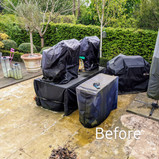- guy727
- Apr 30, 2024
- 2 min read
Tips and Tricks for a Pristine Outdoor Space
A well-maintained patio is an extension of your living space, providing a perfect area for relaxation, entertaining, and enjoying the outdoors. However, keeping your patio clean and looking its best can be a challenge, especially after the very wet weather we have experienced and it has been exposed to the elements. Professional exterior patio cleaning is an effective way to restore your patio to its former glory and extend its lifespan.
Why Professional Patio Cleaning is Important
Over time, patios can become dirty and stained from various sources, including dirt, pollen, mould, mildew, and algae. These contaminants can make your patio look unsightly and can also be harmful to your health. Professional patio cleaning removes these contaminants safely and effectively, leaving your patio looking clean and refreshed.
Which Professional Patio Cleaning Company should you choose?
Look for a reputable and experienced company with a proven track record of success. Here are some factors to consider:
Experience: Look for a company that can show you pictures of previous work and has a good reputation.
Expertise: Make sure the company specialises in patio cleaning and uses the latest cleaning methods and equipment.
Customer service: Choose a company that is responsive to your needs and provides excellent customer service.
What to Expect from a Professional Patio Cleaning
The patio cleaning process typically involves the following steps:
Pre-cleaning: The patio is pre-cleaned to remove loose dirt and debris.
Cleaning: The patio is cleaned using a high-pressure washer and a cleaning solution.
Rinsing: The patio is rinsed with clean water to remove the cleaning solution.
Sealing: The patio can be sealed if required to protect it from future stains and damage.
Tips for Maintaining a Clean Patio
Once your patio has been professionally cleaned, you can take steps to maintain its cleanliness. Here are a few tips:
Sweep or blow off the patio regularly. This will remove loose dirt and debris before it has a chance to build up.
Rinse the patio with a hose regularly. This will help to remove any dirt or stains that have accumulated.
Pressure wash your patio from time to time. To help protect the patio from future stains and damage I recommend jet washing it once in the spring, again in mid summer and then again before the winter weather sets in (around October time).
By following these tips, you can keep your patio looking its best for years to come.
Why not book an exploratory appointment with me today:-
Or call me on 07823 532004
I'd also be delighted if you left a comment below.





























